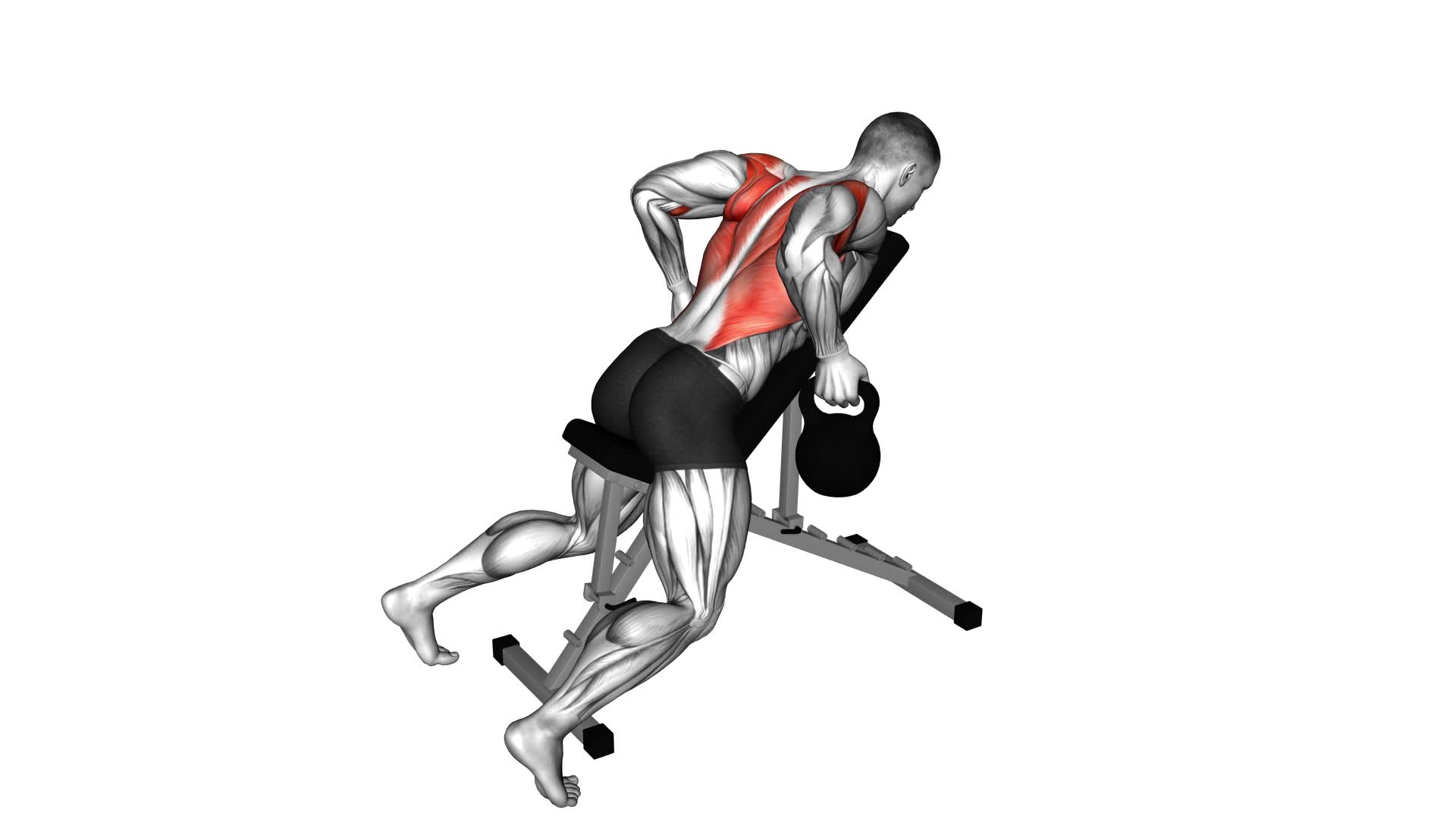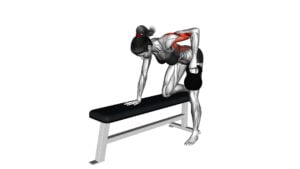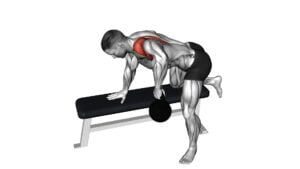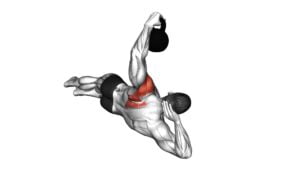Kettlebell Lying Rear Delt Row – Video Exercise Guide & Tips

Are you looking for an effective exercise to target your rear delts? Look no further than the kettlebell lying rear delt row. This exercise is perfect for toning and strengthening your shoulder muscles.
Watch This Exercise Video
In this video exercise guide, we will walk you through the proper form and technique, as well as provide tips for choosing the right kettlebell weight.
Whether you're a beginner or advanced fitness enthusiast, we have modifications and variations to suit all levels.
Get ready to take your workout to the next level with the kettlebell lying rear delt row.
Key Takeaways
- Targets and strengthens rear deltoid muscles
- Provides exceptional muscle activation in rear deltoids
- Improves shoulder stability
- Helps prevent injuries
Benefits of the Kettlebell Lying Rear Delt Row
Experience the numerous benefits of the Kettlebell Lying Rear Delt Row, a highly effective exercise for targeting and strengthening your rear deltoid muscles. This exercise provides exceptional muscle activation in the rear deltoids, which are the muscles located at the back of your shoulders. By incorporating the Kettlebell Lying Rear Delt Row into your workout routine, you can effectively isolate and strengthen these muscles, leading to improved shoulder stability.
One of the key benefits of this exercise is its ability to activate the rear deltoid muscles. As you perform the rowing motion with the kettlebell, the rear deltoids are engaged and activated, leading to increased muscle strength and development. This targeted activation helps to improve the overall strength and stability of your shoulders.
In addition to muscle activation, the Kettlebell Lying Rear Delt Row also promotes shoulder stability. By focusing on the rear deltoids, this exercise helps to strengthen the muscles that support the shoulder joint. This increased stability can be beneficial for preventing injuries and improving overall shoulder function.
Proper Form and Technique for the Exercise
To perform the Kettlebell Lying Rear Delt Row with proper form and technique, start by positioning yourself on a bench or mat. Here are the steps to ensure you have the right form for this exercise:
- Lie face down on the bench or mat, holding a kettlebell in each hand.
- Extend your arms straight out in front of you, palms facing down.
- Keep your legs straight and feet planted on the ground for stability.
- Engage your core and squeeze your shoulder blades together as you lift the kettlebells up towards your chest.
- Pause for a moment at the top of the movement, feeling the contraction in your rear deltoids.
- Slowly lower the kettlebells back down to the starting position, maintaining control throughout the movement.
Proper form is essential for maximizing the benefits of the Kettlebell Lying Rear Delt Row. This exercise primarily targets the rear deltoids, helping to improve shoulder stability and posture. It also engages the upper back muscles and can contribute to overall upper body strength. By maintaining proper form, you'll ensure that you're effectively targeting the intended muscles and reducing the risk of injury.
Choosing the Right Kettlebell Weight
When selecting the right kettlebell weight for the lying rear delt row exercise, it's important to consider proper weight selection to avoid injury risks.
Choosing a weight that's too heavy can strain your muscles and joints, while a weight that's too light may not provide enough resistance for an effective workout.
Proper Weight Selection
Start by assessing your strength and capabilities to ensure that you select the appropriate kettlebell weight for the Kettlebell Lying Rear Delt Row exercise. Here are some weight selection tips to help you find the right weight:
- Start with a lighter weight: If you're new to kettlebell training or unsure of your strength level, it's best to start with a lighter weight. This will allow you to focus on mastering the exercise technique without compromising form.
- Gradually increase the weight: As you become more comfortable with the exercise and your strength improves, you can gradually increase the weight of the kettlebell. This will help you continue challenging your muscles and making progress.
- Listen to your body: Pay attention to how your body feels during and after each set. If the weight feels too easy or you're not feeling any muscle engagement, it may be time to increase the weight. On the other hand, if the weight feels too heavy and you're struggling to maintain proper form, it's important to decrease the weight to avoid injury.
Avoiding Injury Risks
Choose the proper kettlebell weight to avoid injury risks during the Kettlebell Lying Rear Delt Row exercise. Injury prevention should be a priority when engaging in any exercise routine.
To prevent injuries, it's essential to choose a kettlebell weight that's appropriate for your fitness level and strength. Using a weight that's too heavy can put excessive strain on your muscles and joints, increasing the risk of injury. On the other hand, using a weight that's too light may not provide enough resistance to effectively engage your muscles.
Before starting the Kettlebell Lying Rear Delt Row exercise, it's crucial to warm up your muscles with some dynamic stretches or light cardio exercises. This will prepare your body for the workout and reduce the chances of injury.
Moving on, let's discuss some common mistakes to avoid during this exercise.
Common Mistakes to Avoid
To ensure proper form and maximize the effectiveness of the kettlebell lying rear delt row, there are a few common mistakes that you should avoid.
First, make sure that you place the kettlebell in the correct position, resting it securely on your upper back.
Additionally, pay attention to your body alignment, keeping your spine straight and your core engaged throughout the movement.
Lastly, don't neglect the full range of motion, ensuring that you fully extend your arms and squeeze your shoulder blades together at the top of the row.
Incorrect Kettlebell Placement
Place the kettlebell between your feet and under your hips to ensure proper kettlebell placement for the lying rear delt row exercise. Incorrect kettlebell placement can lead to ineffective workouts and potential injuries.
Here are three common mistakes to avoid:
- Placing the kettlebell too far away: If the kettlebell is placed too far from your body, you won't be able to maintain proper form and engage the targeted muscles effectively. Keep the kettlebell within reach to perform the exercise correctly.
- Placing the kettlebell too close: On the other hand, if the kettlebell is too close to your body, it can restrict your range of motion and limit the effectiveness of the exercise. Ensure there's enough space between your body and the kettlebell.
- Placing the kettlebell off-center: Placing the kettlebell off-center can throw off your balance and potentially strain your muscles. Make sure the kettlebell is centered between your feet for stability and optimal results.
Improper Body Alignment
Ensure proper body alignment when performing the lying rear delt row exercise to maximize its effectiveness and minimize the risk of injury.
Improper posture is a common mistake to avoid during this exercise. When your body isn't aligned correctly, it can lead to muscle imbalances and put unnecessary strain on your joints.
To maintain proper alignment, start by lying flat on your stomach with your legs extended and your feet hip-width apart. Keep your spine neutral and engage your core muscles.
As you row the kettlebell towards your chest, make sure to keep your shoulders down and back, and avoid arching your back or lifting your hips.
Neglecting Full Range of Motion
Don't skip out on the full range of motion during the kettlebell lying rear delt row exercise. Neglecting the full range can limit the effectiveness of the exercise and increase the risk of injury. Here are three reasons why you should always prioritize full range of motion:
- Muscle activation: Performing the exercise through its full range allows for maximum muscle activation. This means you'll be targeting and working the rear deltoids more effectively, leading to better results.
- Joint health: Moving through a full range of motion helps to maintain joint health and mobility. Neglecting this can lead to stiffness and decreased range of motion over time.
- Injury prevention: Performing exercises with a limited range of motion can put unnecessary stress on certain muscles and joints, increasing the risk of injury. By prioritizing full range of motion, you'll reduce the likelihood of strains and other injuries.
Modifications and Variations for All Fitness Levels
To modify or vary the Kettlebell Lying Rear Delt Row exercise for all fitness levels, you can incorporate different weights and repetitions. These modifications and progressions allow you to tailor the exercise to your specific needs and abilities.
For beginners or those with limited strength, it's recommended to start with lighter weights. This will help you focus on maintaining proper form and technique. As you become more comfortable with the exercise, you can gradually increase the weight to challenge your muscles further.
If you're looking to increase the intensity of the exercise, you can incorporate higher repetitions. This will help build muscular endurance and stamina. On the other hand, if you prefer to focus on building strength and muscle mass, you can decrease the number of repetitions and increase the weight.
Additionally, you can also experiment with different variations of the exercise. For example, you can try performing the exercise with one arm at a time to increase the instability and engage your core muscles more. Another variation is to perform the exercise in a standing position rather than lying down, which adds an extra element of balance and coordination.
Tips for Incorporating the Kettlebell Lying Rear Delt Row Into Your Workout Routine
To effectively incorporate the Kettlebell Lying Rear Delt Row into your workout routine, focus on maintaining proper form and gradually increase the weight and repetitions according to your fitness level. This exercise targets the rear deltoids, which are the muscles located at the back of your shoulders.
Here are some tips to help you make the most out of incorporating kettlebell rows into your routine:
- Start with a lighter weight: When you're first starting out, it's important to choose a weight that allows you to perform the exercise with proper form. This will help prevent any unnecessary strain or injury.
- Focus on your posture: Maintain a neutral spine and engage your core throughout the exercise. This will help you stabilize your body and target the muscles effectively.
- Increase weight gradually: As you become more comfortable with the movement, gradually increase the weight of the kettlebell to continue challenging your muscles. This will help you build strength and improve your overall performance.
Incorporating kettlebell rows into your workout routine offers several benefits. It helps develop strong and defined rear deltoids, enhances shoulder stability, and improves posture. By following these tips, you can effectively incorporate this exercise into your routine and reap the benefits of rear delt exercises.
Frequently Asked Questions
How Many Sets and Reps Should I Do for the Kettlebell Lying Rear Delt Row?
To determine the number of sets and reps for the kettlebell lying rear delt row, you should consider your fitness goals and current fitness level. Generally, it's recommended to perform 3-4 sets of 8-12 reps for muscle growth and strength. However, you can adjust the sets and reps based on your preferences and capabilities.
Remember to start with a weight that challenges you but allows you to maintain proper form. There are also variations of the kettlebell lying rear delt row that you can incorporate for variety and targeting different muscle groups.
Can I Perform the Kettlebell Lying Rear Delt Row With Dumbbells Instead of Kettlebells?
Yes, you can perform the kettlebell lying rear delt row with dumbbells instead of kettlebells.
While kettlebells offer unique benefits such as improved grip strength and stability, dumbbells can still be a suitable substitution.
The key is to focus on proper form and technique to effectively target your rear delts. Make sure to maintain a neutral spine and engage your shoulder blades throughout the exercise.
Is It Necessary to Warm up Before Doing the Kettlebell Lying Rear Delt Row?
It is necessary to warm up before doing the kettlebell lying rear delt row. A proper warm up has many benefits, such as increasing blood flow to the muscles, improving flexibility, and reducing the risk of injury.
To effectively warm up before kettlebell exercises, you can start with some light cardio, like jogging or jumping jacks, followed by dynamic stretches and mobility exercises for the shoulders and upper back.
This will prepare your body for the workout ahead.
Can the Kettlebell Lying Rear Delt Row Help Improve My Posture?
The kettlebell lying rear delt row is a great exercise for improving your posture. By targeting the muscles in your upper back and shoulders, this exercise helps strengthen the muscles that are responsible for maintaining proper alignment.
Additionally, kettlebell exercises, in general, have been shown to improve overall strength, stability, and flexibility. Incorporating kettlebell training into your routine can provide numerous benefits, including improved posture and better overall body mechanics.
Can I Do the Kettlebell Lying Rear Delt Row if I Have a Shoulder Injury?
If you have a shoulder injury, it's important to modify your exercises to avoid further pain or damage.
The kettlebell lying rear delt row may not be suitable for you in this case. However, there are alternative exercises you can try that focus on strengthening the rear delts without putting strain on your shoulders.
It's always best to consult with a healthcare professional or a certified trainer to determine the best modifications for your specific injury.
Conclusion
In conclusion, the kettlebell lying rear delt row is a highly effective exercise for targeting the rear deltoids. By using proper form and technique, choosing the right kettlebell weight, and avoiding common mistakes, you can maximize the benefits of this exercise.
Additionally, modifications and variations make it accessible for all fitness levels. Incorporating the kettlebell lying rear delt row into your workout routine can help improve your shoulder strength and overall upper body development.

Author
Years ago, the spark of my life’s passion ignited in my mind the moment I stepped into the local gym for the first time. The inaugural bead of perspiration, the initial endeavor, the very first surge of endorphins, and a sense of pride that washed over me post-workout marked the beginning of my deep-seated interest in strength sports, fitness, and sports nutrition. This very curiosity blossomed rapidly into a profound fascination, propelling me to earn a Master’s degree in Physical Education from the Academy of Physical Education in Krakow, followed by a Sports Manager diploma from the Jagiellonian University. My journey of growth led me to gain more specialized qualifications, such as being a certified personal trainer with a focus on sports dietetics, a lifeguard, and an instructor for wellness and corrective gymnastics. Theoretical knowledge paired seamlessly with practical experience, reinforcing my belief that the transformation of individuals under my guidance was also a reflection of my personal growth. This belief holds true even today. Each day, I strive to push the boundaries and explore new realms. These realms gently elevate me to greater heights. The unique combination of passion for my field and the continuous quest for growth fuels my drive to break new ground.







